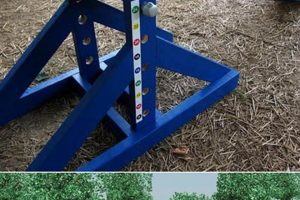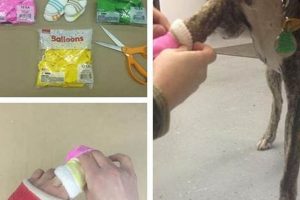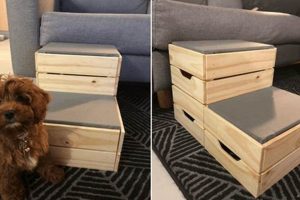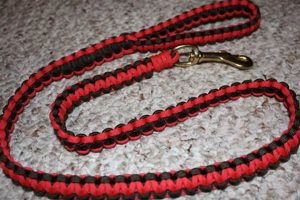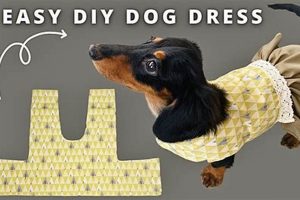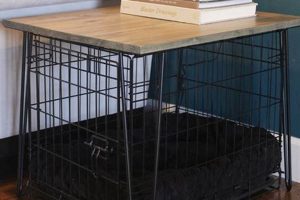Creating absorbent garments for canines at home addresses specific needs, such as managing incontinence, assisting during heat cycles, or preventing marking behaviors. These homemade solutions often utilize readily available materials, including absorbent pads, fabric remnants, and fastening mechanisms like hook-and-loop closures. An example includes repurposing a child’s clothing item with added absorbent layers to provide a comfortable and functional diaper substitute.
The practice of constructing canine incontinence solutions offers several advantages. It allows for customization in sizing and absorbency, accommodating a range of breeds and conditions. This approach can also present a cost-effective alternative to commercially produced options, particularly for owners with multiple animals or those requiring long-term management. Historically, inventive pet owners have sought creative methods to manage their animals’ hygiene needs, leading to diverse adaptations and improvements over time.
Further discussion will explore various construction techniques, material selections, and fitting considerations to assist in effectively crafting these individualized solutions. The objective is to equip individuals with the knowledge to address their canine companions’ specific requirements with tailored, homemade products.
Construction and Usage Guidance
The following guidelines offer practical advice for the fabrication and implementation of canine hygiene solutions.
Tip 1: Material Selection: Prioritize absorbent materials such as flannel, cotton, or microfiber for the inner layers. Consider waterproof or water-resistant fabrics like PUL (polyurethane laminate) for the outer layer to prevent leakage.
Tip 2: Accurate Measurement: Obtain precise measurements of the canine’s waist and length to ensure a secure and comfortable fit. Ill-fitting garments can cause discomfort and reduce effectiveness.
Tip 3: Secure Fastenings: Employ durable and adjustable fasteners such as hook-and-loop closures or snaps. Ensure the fasteners are positioned to prevent chafing or irritation of the animal’s skin.
Tip 4: Tail Hole Placement: Accurately position the tail hole to allow for unrestricted movement and prevent soiling. A template may be useful to ensure consistent placement across multiple constructions.
Tip 5: Absorbent Pad Integration: Design the garment to accommodate replaceable absorbent pads. This allows for easy cleaning and extended use of the constructed item. Commercially available or homemade pads can be utilized.
Tip 6: Hygiene Considerations: Regularly launder the constructed items with a mild detergent to prevent bacterial growth and maintain hygiene. Consider using a mesh laundry bag to protect fasteners during washing.
Tip 7: Gradual Introduction: Introduce the garment to the canine gradually, using positive reinforcement to encourage acceptance. Supervision is recommended during initial wear to ensure the animal does not attempt to remove or damage the item.
These guidelines are intended to assist in the creation of functional and hygienic solutions for managing canine incontinence or hygiene-related needs. Careful attention to material selection, fit, and hygiene practices is crucial for ensuring the comfort and well-being of the animal.
The following section will address common issues and troubleshooting techniques related to the use of these constructed items.
1. Absorbent Material Efficacy and DIY Dog Diapers
Absorbent material efficacy is a critical determinant of the overall functionality and success of homemade canine hygiene solutions. The primary purpose of such a garment is to contain and absorb bodily fluids, preventing soiling of the surrounding environment. Inadequate absorbency directly leads to leakage, negating the intended benefit and potentially creating unsanitary conditions. Therefore, the selection and arrangement of absorbent materials represent a foundational element in the design and construction process. For instance, multiple layers of cotton flannel, known for its high fluid retention capacity, are often utilized as a core absorbent layer in these designs.
The relationship between absorbent material efficacy and practical application is readily demonstrable. A diaper constructed solely from a single layer of non-absorbent fabric, such as nylon, would fail to perform its intended function, irrespective of its fit or fastening system. Conversely, a diaper incorporating multiple layers of highly absorbent materials, such as a combination of hemp and bamboo fleece, significantly reduces the risk of leakage. Real-world examples include older canines experiencing age-related incontinence or female dogs during their heat cycle; in these scenarios, the diaper’s absorbent capacity directly impacts the pet’s comfort and the cleanliness of the home environment. The ability to choose and combine different materials based on their absorbent properties empowers the creator to tailor the item’s performance to the specific needs of the animal.
In conclusion, effective absorbency is indispensable for homemade canine hygiene solutions. The strategic selection and layering of absorbent materials are directly linked to the product’s ability to prevent leaks, maintain hygiene, and ensure the comfort of the animal. This understanding is pivotal for individuals seeking to create functional and reliable solutions, underscoring the importance of prioritizing absorbent properties in the construction process. Challenges may arise in sourcing specific materials or balancing absorbency with comfort, but the fundamental principle remains: absorbent material efficacy dictates the success of the constructed item.
2. Secure, comfortable fit
Achieving a secure, comfortable fit is paramount for the effective utilization of homemade absorbent garments for canines. A poorly fitted garment can lead to discomfort, chafing, and ultimately, a failure to contain bodily fluids. Consequently, a design prioritizing both security and comfort is essential for canine compliance and product effectiveness.
- Accurate Measurement Acquisition
Precise measurement of the canine’s waist circumference and body length is a prerequisite for creating well-fitting absorbent garments. Inaccurate measurements inevitably result in a garment that is either too tight, restricting movement and potentially causing skin irritation, or too loose, allowing for slippage and leakage. For example, a measurement taken with the canine in a seated position can be artificially compressed, leading to an undersized finished product. Accurate measurement, taken while the animal is standing, provides the foundation for a comfortable and secure fit.
- Adjustable Closure Mechanisms
The incorporation of adjustable closure mechanisms, such as hook-and-loop fasteners or elasticized straps, allows for customization and fine-tuning of the garment’s fit. Canines exhibit variation in body shape and size, even within the same breed. A rigid, non-adjustable garment cannot accommodate these variations, potentially causing discomfort or compromising its ability to remain securely in place. The ability to adjust the garment ensures a snug fit without undue pressure, contributing to both comfort and leak prevention.
- Material Selection for Comfort
The choice of materials directly impacts the comfort level of the garment. Rough or abrasive fabrics can cause chafing and skin irritation, particularly in sensitive areas such as the inner thighs. Prioritizing soft, breathable materials, such as cotton flannel or fleece, minimizes the risk of irritation and enhances overall comfort. In contrast, stiff or non-breathable materials can trap moisture and exacerbate skin problems. Material selection must consider both absorbency and comfort factors to achieve optimal performance.
- Tail Hole Placement and Design
The design and placement of the tail hole are crucial for comfort and functionality. An improperly positioned or sized tail hole can restrict tail movement, causing discomfort and potentially leading the canine to attempt to remove the garment. A design that allows for free and natural tail movement minimizes interference and enhances overall acceptance. The tail hole should be reinforced to prevent fraying and maintain its shape, ensuring long-term durability and functionality.
The integration of accurate measurements, adjustable closures, comfortable materials, and thoughtfully designed tail openings collectively contributes to a secure and comfortable fit. This integration is not merely an aesthetic consideration but a functional requirement for effective canine hygiene management using homemade solutions. Practical application demonstrates that a well-fitted garment is more likely to be tolerated by the animal, leading to consistent use and the desired outcome of containing bodily fluids.
3. Leakage prevention methods
Effective containment of bodily fluids represents a primary objective in the design and construction of homemade absorbent garments for canines. Strategies to mitigate leakage are integral to the overall functionality and practicality of these items, directly impacting their suitability for managing incontinence, heat cycles, or marking behaviors.
- Waterproof Outer Layer Selection
The incorporation of a waterproof or water-resistant outer layer is crucial for preventing fluid seepage. Materials such as PUL (polyurethane laminate) or coated nylon provide a barrier against moisture penetration, safeguarding surrounding surfaces and preventing skin irritation caused by prolonged exposure. The effectiveness of this layer hinges on its integrity; tears or punctures compromise its protective function. Regular inspection and maintenance are necessary to ensure continued efficacy.
- Absorbent Core Composition and Layering
The internal absorbent core directly influences the garment’s capacity to retain fluids. Strategic layering of different absorbent materials, such as cotton flannel, microfiber, and hemp fleece, optimizes fluid distribution and retention. Concentrating highly absorbent materials in areas of greatest need, such as the perineal region, enhances overall leakage prevention. Adequate thickness of the absorbent core is essential to prevent saturation and subsequent leakage under pressure.
- Elasticized Leg Gussets and Edges
Elasticized leg gussets and edges create a snug seal around the canine’s legs, minimizing gaps through which fluids can escape. The elasticity of these components allows for a comfortable fit while maintaining a secure barrier. Properly sized and positioned elastic is necessary to prevent chafing or restriction of movement. The tension of the elastic should be sufficient to create a seal without causing discomfort to the animal.
- Secure Fastening System Integrity
A secure fastening system prevents displacement of the garment, which can lead to leakage. Hook-and-loop closures, snaps, or adjustable straps maintain the garment’s position, ensuring continuous coverage of the intended area. The strength and durability of the fastening system are critical; weak or damaged closures compromise its ability to maintain a secure fit. Regular inspection and replacement of worn fasteners are recommended.
The integration of these leakage prevention methods is paramount for the successful application of homemade absorbent garments. The effectiveness of each method is interdependent; a compromised outer layer, for example, renders a highly absorbent core less effective. Careful consideration of material selection, design, and construction techniques is essential for creating reliable and functional solutions for managing canine hygiene needs.
4. Washable, reusable designs
The creation of absorbent garments for canines, produced through a do-it-yourself approach, often prioritizes washable and reusable designs. This emphasis stems from several factors, including cost-effectiveness, environmental considerations, and customization options. The cause is a desire for sustainable and economically viable solutions for managing canine incontinence, heat cycles, or marking behaviors. The effect is the development of absorbent garments that can be laundered and utilized repeatedly, reducing reliance on disposable alternatives.
Washable and reusable designs are an integral component of homemade absorbent garments because they address practical concerns associated with long-term use. Disposable options, while convenient, incur recurring costs and contribute to landfill waste. Conversely, reusable garments, constructed from durable fabrics and secure fasteners, offer a more sustainable and economical solution. For example, a canine experiencing chronic incontinence requires continuous diapering; a washable design significantly reduces the financial burden and environmental impact compared to single-use products. The capacity to launder and reuse these garments ensures hygiene and convenience while minimizing waste generation.
The practical significance of understanding the connection between washable, reusable designs and do-it-yourself absorbent garments lies in empowering pet owners to create sustainable and cost-effective solutions tailored to their animals’ specific needs. Individuals gain the ability to select appropriate materials, implement durable construction techniques, and design garments that withstand repeated laundering cycles. This knowledge contributes to responsible pet ownership, reducing reliance on disposable products and promoting environmentally conscious practices. The challenges associated with designing and constructing durable, washable garments involve selecting fabrics that retain their shape and absorbency after multiple washings, employing secure fastening systems that withstand laundering, and ensuring proper hygiene practices to prevent bacterial growth. Addressing these challenges ensures the longevity and efficacy of homemade, reusable absorbent garments for canines.
5. Cost-effectiveness
The economic benefit derived from constructing canine absorbent garments at home constitutes a primary motivator for many pet owners. Commercially available options, particularly disposable varieties, represent a recurring expense. The initial outlay for materials required to create homemade solutions, conversely, typically amortizes over time due to the reusable nature of these items. Furthermore, access to readily available fabrics and repurposing existing materials further reduces the financial burden. The cause is a desire to minimize expenses associated with managing canine incontinence, heat cycles, or behavioral marking. The effect is the adoption of do-it-yourself methods to produce cost-effective alternatives to commercially manufactured products.
The importance of cost-effectiveness as a component of these homemade items is demonstrable through direct comparison. A canine requiring daily diapering due to incontinence presents a significant financial commitment when relying on disposable products. The recurring cost of these disposables can quickly exceed the initial investment in materials necessary to create a set of washable, reusable diapers. For example, the cost of a single disposable diaper, multiplied by the number of days in a year, represents a considerable sum. Conversely, the cost of fabric, fasteners, and absorbent materials for homemade diapers is a one-time expense that yields significant savings over time. Moreover, the ability to customize the design and materials allows for optimization of cost without compromising functionality. This understanding is significant because it empowers pet owners to manage their animals’ hygiene needs without incurring excessive financial strain.
In summary, the pursuit of cost-effectiveness is a central driver behind the adoption of do-it-yourself canine absorbent garments. The ability to create reusable and customizable solutions from readily available materials translates into significant savings over time. While challenges may arise in identifying durable materials or mastering construction techniques, the long-term economic benefits make homemade diapers a compelling alternative to commercially available options. This approach aligns with a broader trend toward sustainable and financially responsible pet ownership, promoting resourcefulness and minimizing unnecessary expenditures.
Frequently Asked Questions
The subsequent questions and answers address common inquiries regarding the creation and utilization of homemade absorbent garments for canines. These responses are intended to provide clear and informative guidance based on established practices and practical considerations.
Question 1: Are constructed canine diapers as effective as commercially manufactured options?
The effectiveness of constructed canine diapers is contingent upon material selection, design, and construction quality. A well-designed and properly constructed item, utilizing absorbent materials and a secure fastening system, can achieve comparable performance to commercially available alternatives. However, inferior materials or poor construction may compromise functionality.
Question 2: What types of materials are most suitable for homemade canine absorbent garments?
Suitable materials include absorbent fabrics such as cotton flannel, microfiber, and hemp fleece for inner layers, combined with a waterproof or water-resistant outer layer such as PUL (polyurethane laminate). Fasteners such as hook-and-loop closures or snaps are necessary to secure the garment.
Question 3: How frequently should homemade canine diapers be changed?
The frequency of diaper changes depends on the animal’s individual needs and the absorbent capacity of the garment. Regular monitoring is necessary to determine the appropriate change interval. Diapers should be changed promptly upon becoming soiled to prevent skin irritation and maintain hygiene.
Question 4: Are homemade canine diapers suitable for all breeds and sizes?
Constructed canine diapers can be adapted to fit a variety of breeds and sizes through customized measurement and design. Accurate measurement of the animal’s waist and length is essential for achieving a secure and comfortable fit. The design should accommodate the animal’s body shape and movement.
Question 5: How should homemade canine diapers be cleaned and maintained?
Constructed canine diapers should be laundered regularly with a mild detergent. Avoid using harsh chemicals or bleach, as these can damage the materials and irritate the animal’s skin. Fasteners should be secured prior to laundering to prevent snagging. Air drying or low-heat tumble drying is recommended to prevent shrinkage or damage to the waterproof layer.
Question 6: What are the potential risks associated with using homemade canine diapers?
Potential risks include skin irritation, chafing, and infection if the diaper is not properly fitted, changed frequently, or cleaned regularly. Allergic reactions to certain materials are also possible. Regular monitoring of the animal’s skin is recommended to identify and address any potential problems.
Effective utilization of homemade canine diapers requires careful attention to design, construction, hygiene, and monitoring. While these items offer a cost-effective and customizable alternative to commercially available options, responsible use is essential for ensuring the animal’s health and well-being.
The subsequent section will provide a conclusion to this discussion.
Conclusion
The foregoing exploration of “diy dog diapers” has illuminated key facets of their creation and utilization. Considerations encompassing material selection, construction techniques, fit optimization, and hygiene protocols are integral to achieving functional and reliable outcomes. The pursuit of cost-effectiveness and sustainable practices frequently motivates individuals to adopt this approach, providing tailored solutions for specific canine needs.
Ultimately, the successful implementation of constructed canine absorbent garments hinges on informed decision-making and diligent execution. Continued research and refinement of these techniques hold the potential to further enhance their efficacy and accessibility, fostering responsible pet ownership and promoting the well-being of canine companions.


